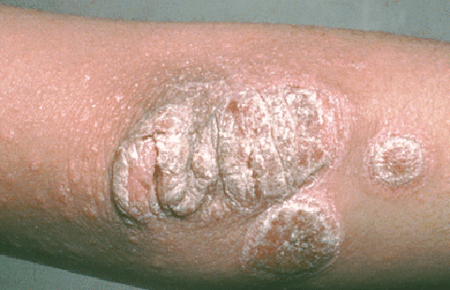What does psoriasis look like?
There are different types of psoriasis. Most people have a type called plaque (pronounced plack) psoriasis. It’s possible to have more than one type of psoriasis. What you see on your skin varies with the type of psoriasis you have and where it appears on your body. The following pictures will give you an idea of what the different types of psoriasis can look like.
Plaque (plack) psoriasis
Patches of thick raised skin covered with silvery scale form. These patches usually appear on the scalp, elbows, knees, or lower back — but they can develop anywhere on the skin.

Scalp psoriasis
On the scalp, the psoriasis may be thin or thick. Very thick patches can lead to hair loss. Whether thick or thin, the patches can extend beyond the scalp to the forehead, neck, or ears.

Nail psoriasis
This can develop with any type of psoriasis. Signs include yellow-brown spots on the nails, pitted nails, crumbling nails, and nails separating from fingers or toes.

Guttate (gut-tate) psoriasis
This type often develops in children, who get it after they’ve had an infection, such as strep throat. Guttate psoriasis tends to cause lots of small, scaly spots.

Inverse psoriasis
Found where skin touches skin, such as the armpit (left) or groin area (right), this type causes shiny, smooth patches instead of scaly ones. This psoriasis is often bright red and the skin may be sore.

Pustular psoriasis
On their hands and feet, people develop painful pus-filled blisters and thick, scaly skin that cracks easily.

Generalized pustular psoriasis
Rare and very serious, this type of psoriasis requires emergency medical care. It begins with dry, red, and tender skin. Within hours, widespread pus-filled blisters appear.

Erythrodermic (eh-rith-row-der-mic) psoriasis
This type of psoriasis causes large areas of skin to look burnt. Anyone who has skin that looks burnt should see a doctor immediately because this type of psoriasis can be life threatening.

Images
All photos used with permission of the American Academy of Dermatology National Library of Dermatologic Teaching Slides, except for the following:
Inverse psoriasis (left): Photograph used with permission of the Journal of the American Academy of Dermatology. J Am Acad Dermatol 2004;51:731-8.
Generalized pustular psoriasis: Photograph used with permission of the Journal of the American Academy of Dermatology. J Am Acad Dermatol 2013;68:e187-9.
Erythrodermic psoriasis: Photograph used with permission of the Journal of the American Academy of Dermatology. J Am Acad Dermatol 2008;58:826-50.
References
Menter, A, Gottlieb A, et al. “Guidelines of care for the management of psoriasis and psoriatic arthritis Section 1. Overview of psoriasis and guidelines of care for the treatment of psoriasis with biologics.” J Am Acad Dermatol 2008;58:826-50.
 Atopic dermatitis: More FDA-approved treatments
Atopic dermatitis: More FDA-approved treatments
 Biosimilars: 14 FAQs
Biosimilars: 14 FAQs
 How to trim your nails
How to trim your nails
 Relieve uncontrollably itchy skin
Relieve uncontrollably itchy skin
 Fade dark spots
Fade dark spots
 Untreatable razor bumps or acne?
Untreatable razor bumps or acne?
 Tattoo removal
Tattoo removal
 Scar treatment
Scar treatment
 Free materials to help raise skin cancer awareness
Free materials to help raise skin cancer awareness
 Dermatologist-approved lesson plans, activities you can use
Dermatologist-approved lesson plans, activities you can use
 Find a Dermatologist
Find a Dermatologist
 What is a dermatologist?
What is a dermatologist?